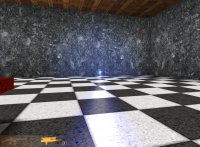![]()
PROJECTS /
PHOTO /
BIOGRAPHY /
CONTACT
![]()
| OpenGL demo -- First Person Shooter | 9 Jul. 04 |
|
 This
demo is the start of a simple First Person Shooter game from Steve Wortham. There are no
monsters, zombies, Nazis, or 2D sprites to shoot yet -- just you in a room
by yourself with 2 big guns. But I think it is very useful OpenGL demo for
beginners. It shows how to implement radiosity to render lightmaps,
multitexturing to apply the lightmaps and a particle engine. This
demo is the start of a simple First Person Shooter game from Steve Wortham. There are no
monsters, zombies, Nazis, or 2D sprites to shoot yet -- just you in a room
by yourself with 2 big guns. But I think it is very useful OpenGL demo for
beginners. It shows how to implement radiosity to render lightmaps,
multitexturing to apply the lightmaps and a particle engine.- Thanks, Steve Wortham steve@gldomain.com http://www.gldomain.com/ |
||
|
|
| Quadrilateral Surface Mesh ( 3D Paving ) | 29 Mar. 04 |
|
| Delaunay type triangular surface Mesh | 31 Oct. 03 |
|
| IGES Viewer | 5 Sep. 03 |
|
| Custom-Shaped OpenGL Window | 9 Aug 03 |
|
| Delaunay Trianglation Mesh Generation | 11 Feb 03 |
|
| Convex Hull of 2D Point Set | 3 Dec 02 |
|
| Reflection and shadow | 3 Aug 02 |
|
|
(Program that were contributed to the GLUT distribution from www.opengl.org) �� |
||
|
|
| Transparent 3D Demo | 30 Jul 02 |
|
| 我在网上搜罗到的一个效果很不错的
- 按下左键,移动鼠标为XY方向的Rotate 好好为之赞叹吧! |
||
|
|
| Site Up | 24 Jul 02 |
|
| Welcome!
Today, I've started Ziyoo homepage, which is about programming in Computer graphics. Mesh, OpenGL and Surface with C++. I hope you find what you're looking for or something else that interests you.
|
苏ICP备05065565号-1
Copyright (C) 2006-2024 南京斯沃软件技术有限公司